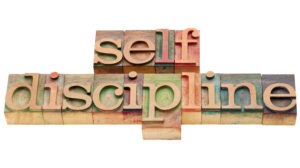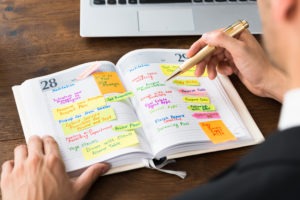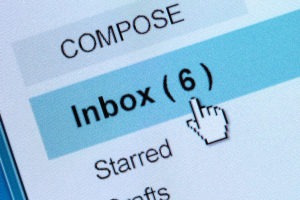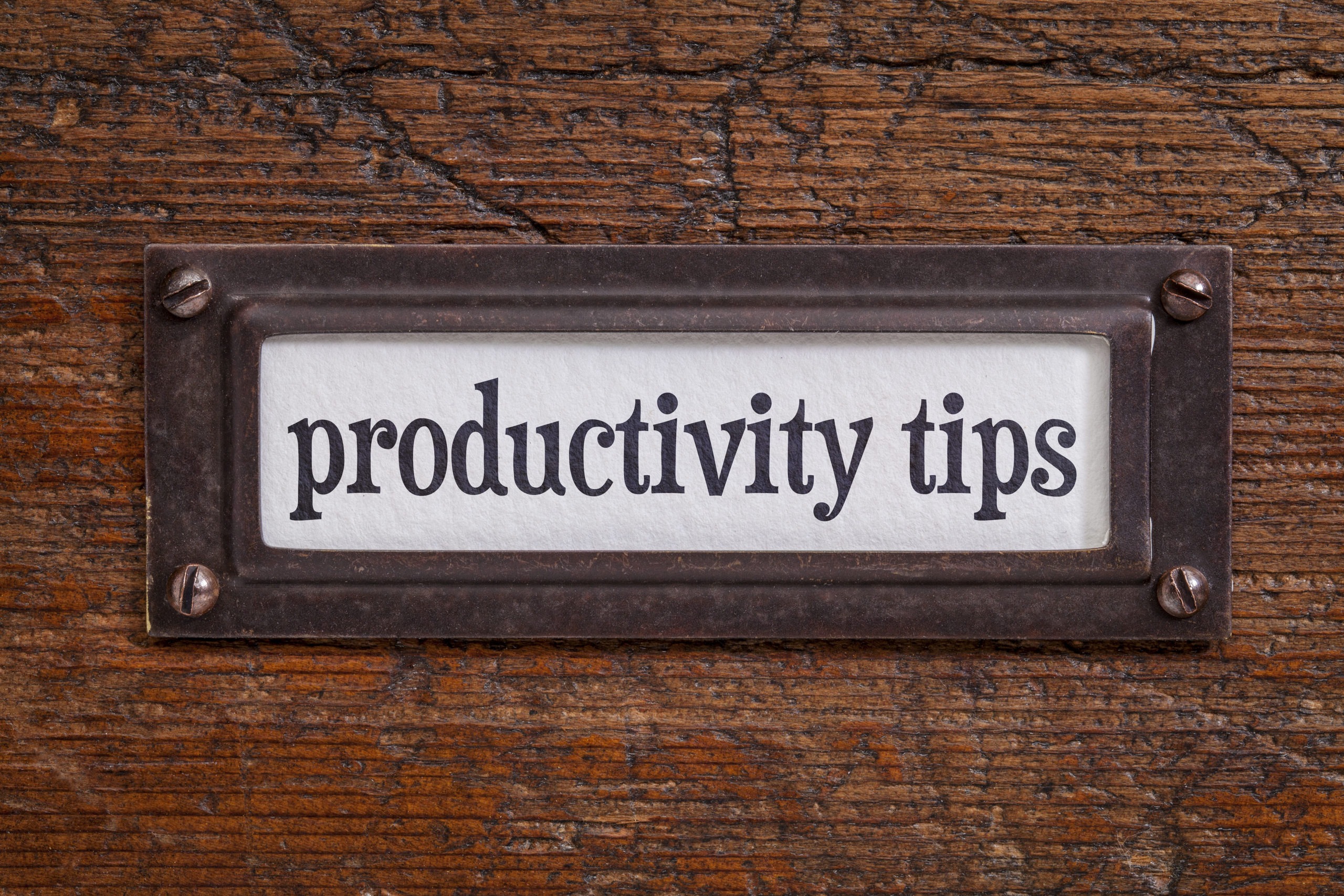Do you need or want to know how to improve your productivity at work? Knowing how to focus on work and not get distracted when you’re feeling stressed, unmotivated or struggle with procrastination is not easy. How to improve productivity working from home during this pandemic is even more challenging for some.
Did you know, the average American office employee spends only two hours and 53 minutes on productive work daily? 85% of workers report being actively disengaged in the office, costing US companies $550 billion from lost productivity.
In this article, I’m going to show you how to improve your workflow process with 12 practical workplace productivity tips. Learn how to do more with these easy-to-implement strategies that will help you improve productivity and time management, develop a productive routine, promote a positive workflow state, and help you maintain a deep focus to accomplish your tasks and meet your goals.
STRATEGY #1 – DEVELOP SELF DISCIPLINE

Self-discipline helps you stay focused in order to reach your goals. It is an essential asset because it helps you get things done and creates a can-do attitude.
In a working environment where employees are encouraged to develop and practice self-discipline, the need for supervisory intervention is greatly reduced.
Now here are some ways to help you develop self-discipline at work.
Make sure you KNOW EXACTLY WHAT IS EXPECTED OF YOU. If you need to improve at any aspect of your job, ask your supervisor to spend a little time helping you understand HOW you can adjust your focus and priorities, and TOGETHER identify any additional training that would help.
Ask them to indicate the results that your efforts will have on the team and the organization. This will help you see past the small details and have something worth striving for as well as help you take ownership of tasks. When you own certain tasks, you’ll have more freedom when making decisions, which in turn improves self-discipline.
STRATEGY #2 – SET SELF IMPOSED DEADLINES
When tasks don’t have an exact deadline, it can be tempting to push them back until eventually nothing gets completed. So set your own deadlines. These deadlines create a false sense of urgency, helping you keep on task and avoid procrastination.
Self-imposed deadlines also create a manageable level of stress so that you can focus and meet your goals.
STRATEGY #3 – DEVELOP STRONG TIME MANAGEMENT SKILLS
One of the key traits of productivity is efficient time management. As American Entrepreneur Jim Rohn once said, “Time is more valuable than money. You can get more money, but you can’t get more time.”
Develop a productive routine by actively using calendars and task lists. This will help you identify limitations to help prevent overextending yourself. A realistic workload will help you reduce stress and have better focus.
Get into the habit of practicing organizational skills both at work and in your personal life.
STRATEGY #4 – DECLUTTER AND ORGANIZE
Messes may seem harmless BUT having too much clutter on your desk and workspace can lead to emotional distress and chaos. Clutter distracts you, bombards your mind with stimuli, and can create feelings of guilt. Having less clutter will help you focus and waste less time.
In fact, studies show that having less stuff can actually reduce your anxiety levels and increase your productivity.
Check out these tips to declutter and organize your workspace.
- Toss out or shred old papers on your desk and create organized documents according to the level of importance.
- Keep personal items trinkets and decorations to a minimum. If you like, copy my 3 things rule – one that inspires me, makes me smile, and something a little fun. When I worked in the corporate world I had a photo of me with my family, a mini battery-operated water fountain, and a fuzzy yellow wind-up chick that would peep when I held it and hopped across my desk if you wound it – that always made me laugh on a bad day.
- Arrange your office space so that you have a clear path to enter, exit, and navigate around your desk, if you’re tripping over shredders, boxes, or stacks of paper that’s just stressful.
- Organize digital files.
- Delete old files on your desktop or store them in the cloud or an external hard drive.
- Have a structured labeling system for your folders.
- Unsubscribe from irrelevant or nonessential email lists. Raise your hand if you are or have been an e-newsletter hoarder – I would subscribe and let them pile up in my inbox with the good intention that one day when I had time, I would go back and read through them. Well, that would never happen, and I would end up with an inbox full of unread emails. A couple of years ago I created a new rule where I go through my subscription emails about every 3 months (I do a sort) and if I haven’t read their monthly newsletter in the last 3 months then I’m likely not going to read it in the future either, so I unsubscribe.
STRATEGY #5 – CREATE TO-DO LISTS
To-do lists give structure to your workday and provide you with a plan you can follow. I love to-do lists – It’s very satisfying to check off the tasks on the list once you’re done it’s now a “ta-da” list. (I couldn’t resist saying that) Make sure your to-do list is prepared the afternoon or night before so that you can start your new day by looking at all the tasks that need to be done. There are plenty of apps and organizational platforms that allow you to assign tasks, organize workflow, and track work progress. Some popular ones are Asana, Microsoft Outlook, and Notion. Asana is great for sharing tasks, projects, and progress and can be edited by team members.
 STRATEGY #6 – SCHEDULE YOUR DAY
STRATEGY #6 – SCHEDULE YOUR DAY
There are many ways to create a schedule. One of the most effective ways is to break your day into chunks of time, whether by 15 minutes, 30-minute increments, or a full hour. Block your day into equal chunks of time and assigned tasks for each one. This makes it easier for you to track progress. As much as possible, try tackling the tasks that require the most focus or mental power during the time of day that you are most energetic.
STRATEGY #7 – PRIORITIZE TASKS
Prioritizing tasks involves taking into account which tasks to focus on and choosing which tasks to put off for later or not do. Remember there may be some tasks that you can delegate or complete in some other way. Although prioritizing responsibilities is a huge part of being a leader or manager, it’s not an easy endeavor, especially when the work is piling up. Nonetheless, keep in mind that if everything is important then nothing is. If you’re spending all day jumping between tasks, trying to complete all of them you’re wasting precious time and energy. Instead, focus on key tasks and assignments and get them off your to-do list.
In the words of Richard Bach, “The shortest way to do many things is to do only one thing at a time.” So, this leads me to…
STRATEGY #8 – DON’T MULTITASK
Contrary to popular belief, multitasking is not an efficient way to complete work. Trying to do so many things at the same time is more likely to result in lost time inefficiencies and disappointing results. If you want to get things done and done right, commit to your schedule and complete one task at a time. Research shows that multitasking lowers one’s IQ and reduces one’s performance. It is a proven productivity killer. It’s better to do one task and get excellent results instead of three tasks with mediocre outcomes. If you find your focus drifting towards another task or screen, resist temptation and give what you are doing your full attention.
STRATEGY #9 – REMOVE DISTRACTIONS
Distractions are constant no matter what type of work you are doing, or which industry your company is in. Social media, interruptions from coworkers, smartphone notifications, or outside noise can all damage productivity because of attention switching. Each distraction causes you to switch your focus and it will take some time to regain the level of productivity you had before you got distracted. Try the following recommendations to reduce the number of distractions while you are working.
- Invest in noise-canceling headphones.
- Turn off your phone and social media notifications during your work hours.
- Avoid texting or answering personal phone calls while you are working on key tasks.
- Only answer emails during a specific time of the day.
- Stay away from uncomfortable or noisy workspaces.
- Move to a quieter environment if possible.
STRATEGY #10 – LIMIT MOBILE NOTIFICATIONS
Your phone creates a world of distraction that can easily lead to minutes if not hours of wasted time. Unless you are actually using your phone to work such as when you are promoting the company on social media. It’s better to keep it away from your site and turn off notifications from distracting apps. This will better help you maintain a deep focus on what you’re working on. Use the Do Not Disturb mode on your phone to stop notifications from bothering you while you’re working.
STRATEGY #11 – AUTOMATE
If you are spending a lot of time on repetitive tasks every day, remember that there are other solutions that you can try to manage your time better. Automating helps improve business productivity by reducing the need for human input on simple repetitive tasks. It’s also the perfect option if there are tasks that need to be done but are beyond your direct expertise.
Here are some examples of tasks that can be automated for increased productivity and efficiency:
- Marketing tasks including reminder emails, follow-up messages, and targeting specific customers for particular promotions, using autoresponders and sales funnels.
- appointment scheduling and other administrative tasks,
- paying bills
- updating records,
- approving common requests.
- CRM updates,
- aggregating data for the creation of business intelligence reports.
STRATEGY #12 – IMPROVE EMAIL MANAGEMENT
One of the top guidelines to live by when it comes to dealing with emails is to never open them unless you actually have the time to respond. Opening emails when you don’t have time to answer them takes away your focus on your current tasks. Plus, you’ll have to spend time reading them again when you get the time to respond. Instead, let them sit in your inbox until you can actually focus on that. Aim to respond to email within two minutes or less. For internal communication, consider using group chats and instant messaging tools to reduce your team’s workload.
In the words of Charles Buxton. “You will never find time for anything. If you want time, you must make it.”
I hope these strategies help you be more productive in your work and home life.
Please share this article with someone you know who might benefit from it, and remember to subscribe to my YouTube channel (VirtualJobSearchCoach), for great videos on topics related to job search strategies, interview tips, and thriving in your career.
If you would like one-to-one coaching to equip you with the confidence, necessary tools, critical knowledge, and strategies to find and land your ideal job – then let’s talk! You can book a complimentary 15 minute discover call directly in my calendar at https://calendly.com/virtualstacey and let’s chat about how I can help you fast-track your job search success.


